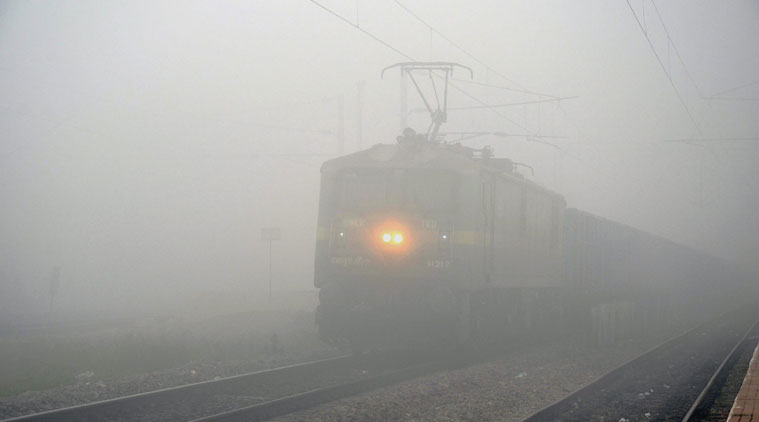A blinding layer of fog over north India and eastern parts of the country on Sunday affected the movement of over 480 trains even as an intense cold wave walloped the plains, including Delhi, where the minimum temperature plunged to a numbing 1.9 degrees Celsius.
Delhi’s minimum temperature was lower than most of the places in Himachal Pradesh and Uttarakhand for the fourth consecutive day, according to the meteorological department. ”Around 335 trains have been delayed, 88 cancelled, 31 diverted and 33 short terminated due to foggy weather,” a railway official said. The Delhi International Airport Limited tweeted that flights, which are not CAT III compliant, may get affected.
Passengers have been advised to contact the airline concerned for updated flight information.
Around 25 flights were delayed Sunday morning, officials said. According to the India Meteorological Department (IMD), visibility levels dropped to zero meters at Bhatinda and Agra; 25 metres at Patiala, Chandigarh, Hissar, Alwar, Pilani, Ganganagar, Lucknow and Cooch Behar; 50 metres at Amritsar and Ludhiana, Ambala, Bhiwani, Palam (Delhi), Fursatganj, Varanasi, Meerut, Gaya and Dhubri. Rohtak in Haryana; Safdarjung, Ridge and Ayanagar in Delhi; Gorakhpur and Bahraich and Bareilly in Uttar Pradesh; Bhagalpur in Bihar; Bagdogra and Jalpaiguri in West Bengal; and several places in Assam, Meghalaya and Tripura recorded a visibility level of 200 metres, it said.
According to the weather office, ‘very dense fog’ is when visibility is between 0 and 50 metres, between 51 and 200 metres is ‘dense’, between 201 and 500 metres ‘moderate’, and between 501 and 1,000 metres ‘shallow’.
A severe cold wave walloped Delhi on Sunday, with the minimum temperature at the Safdarjung observatory, the city’s primary weather station, plunging to 1.9 degrees Celsius, the lowest in January in two years.
With frosty winds from the snow-clad mountains pounding northwest India, including Delhi, the weather stations at Lodhi Road, Ayanagar, Ridge and Jafarpur logged a minimum temperature of 2.8 degrees, 2.6 degrees, 2.2 degrees and 2.8 degrees Celsius, respectively.
It was the fourth day on the trot that the national capital’s minimum temperature was lower than most of the hill stations in Himachal Pradesh and Uttarakhand, including Chamba (8.2 degrees), Dalhousie (8.2 degrees), Dharamshala (6.2 degrees), Shimla (9.5 degrees), Hamirpur (3.9 degrees), Manali (4.4 degrees), Kangra (7.1 degrees), Solan (3.6 degrees), Dehradun (6 degrees), Mussoorie (9.6 degrees), Nainital (6.2 degrees), Mukteshwar (6.5 degrees) and Tehri (7.6 degrees), according to the IMD.
The mercury dropped to 1.4 degrees Celsius in Haryana’s Hisar, 2.8 degrees Celsius in Punjab’s Adampur, minus 0.5 degree Celsius in Churu and 1.5 degrees Celsius in Pilani in Rajasthan; 3.2 degrees Celsius in Prayagraj and 3.8 degrees Celsius in Varanasi in Uttar Pradesh; 2.9 degrees Celsius in Gaya in Bihar; minus 1 degree Celsius in Nowgong and 1.5 degrees Celsius in Umaria in Madhya Pradesh, the IMD said. The Safdarjung observatory had logged a minimum temperature of 2.2 degrees Celsius on Saturday, 4 degrees Celsius on Friday, 3 degrees Celsius on Thursday and 4.4 degrees Celsius on Wednesday.
A severe cold wave had brought the minimum temperature down to 1.5 degrees Celsius at the Ridge weather station in central Delhi.
Several places in the capital had recorded the maximum temperature at least seven notches below normal, making it a severe cold day.
The cold snap is also straining power grids and posing challenges to the homeless and animals. Delhi’s peak winter power demand rose to a record 5,526 MW on Friday.
The IMD warned of an impact on agriculture, livestock, water supply, transport and the power sector at some places.
The weather office also said frostbite can occur due to a prolonged exposure to cold and that one should not ignore shivering — the first sign that the body is losing heat — and should stay indoors.
”Eat vitamin C-rich fruits and vegetables and drink sufficient warm fluids to maintain adequate immunity. Avoid or limit outdoor activities,” it said in an advisory.
The MeT office had issued an ”orange” alert for certain parts of north India, including Delhi, for Sunday, warning that dense fog, cold day and cold wave conditions would persist.
”Cold wave to severe cold wave conditions are very likely to continue over some areas in Rajasthan and Haryana, Chandigarh and Delhi on January 8,” it said.
However, short-term slight relief is likely after a couple of days under the influence of back-to-back western disturbances, the IMD said.
In the plains, the MeT office declares a cold wave if the minimum temperature dips to 4 degrees Celsius or when it is 10 degrees Celsius and 4.5 notches below normal.
A severe cold wave is when the minimum temperature dips to 2 degrees Celsius or the departure from the normal limits is by more than 6.4 notches.
A cold day is when the minimum temperature is less than or equal to 10 degrees Celsius and the maximum temperature is at least 4.5 notches below normal.
A severe cold day is when the maximum temperature is at least 6.5 notches below normal.
(This story has not been edited by Newsd staff and is auto-generated from a syndicated feed.)


















